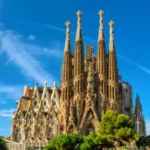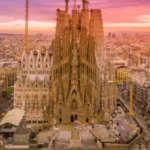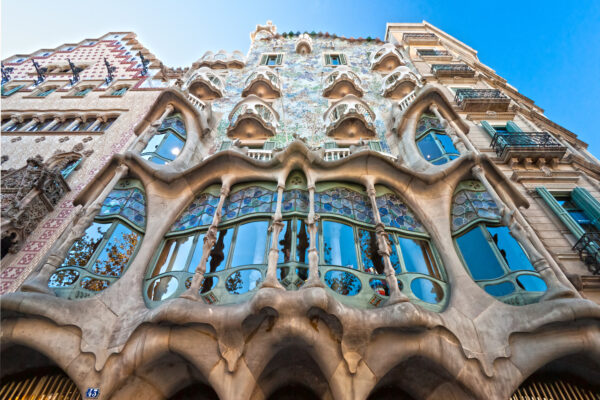
Antoni Gaudí, a master of architecture and design, left an indelible mark on Barcelona with his unique and imaginative creations. His works reflect a deep connection to nature, vibrant colors, and intricate details, making them iconic landmarks of the city.
Among the most celebrated structures are the **Famous Gaudí-designed buildings in Barcelona**, which showcase his innovative approach and visionary ideas. From the whimsical shapes of Park Güell to the towering spires of the Sagrada Familia, each building tells a story that captivates visitors from around the globe.
Famous Gaudí Buildings in Barcelona: A Comprehensive Guide
When exploring the famous Gaudí buildings in Barcelona, one cannot overlook the stunning Casa Batlló. This architectural gem, with its undulating façade and vibrant mosaics, is a testament to Gaudí's ability to incorporate natural forms into modern design. Visitors are often entranced by the building's organic shapes and the clever use of light and color that transforms its interior into a living work of art.
Another highlight is the Casa Milà, popularly known as La Pedrera. This innovative structure features a wavy stone exterior and a rooftop adorned with fantastical chimney sculptures. The building's design exemplifies Gaudí's commitment to breaking conventional architectural norms, allowing it to become both a residential space and a canvas for artistic expression. Its unique structure has earned it recognition as a UNESCO World Heritage site.
Not to be missed is Park Güell, a vibrant public park that showcases Gaudí's eclectic style. The park is filled with colorful mosaics, whimsical structures, and lush greenery, making it an ideal spot for relaxation and exploration. Highlights within the park include the iconic serpentine bench and the striking dragon fountain at the entrance, both of which illustrate Gaudí's genius in merging architecture with nature.
In addition to these landmarks, the Sagrada Familia stands as Gaudí's most ambitious project, still under construction over a century after its inception. Its intricate facades and soaring towers reflect a blend of Gothic and Art Nouveau styles. As the centerpiece of Barcelona, the Sagrada Familia draws millions of visitors each year, captivated by its grandeur and the spiritual vision behind its design. This masterpiece encapsulates the essence of Gaudí's architectural philosophy.
Exploring the Architectural Wonders of Gaudí in Barcelona
Exploring the architectural wonders of Gaudí in Barcelona offers a unique journey into the mind of one of the most celebrated architects of the modern era. His ability to blend natural forms with architectural innovation is evident in every corner of the city. From the vibrant facades to the intricate interior designs, Gaudí's works are not just buildings, but living entities that tell the story of his artistic vision.
Visitors to Barcelona can embark on a tour of Gaudí's masterpieces, each showcasing distinct characteristics that reflect his artistic philosophy. Some of the must-see highlights include:
- Sagrada Familia - A monumental basilica that continues to evolve, symbolizing the fusion of faith and creativity.
- Casa Batlló - Known for its colorful mosaics and organic shapes, it stands as a testament to Gaudí's genius in design.
- Park Güell - A public park filled with fantastical sculptures and vibrant mosaics that illustrate harmony with nature.
- Casa Milà (La Pedrera) - A residential building with a wavy stone facade and whimsical chimneys, exemplifying innovative architecture.
Each of these sites reflects Gaudí's profound connection to the environment and his pioneering spirit. The architectural wonders of Gaudí not only define the skyline of Barcelona but also serve as a source of inspiration for architects and artists worldwide. As you wander through the city, you'll discover that every building invites you to ponder the intricate relationship between art, nature, and humanity.
In conclusion, exploring the architectural wonders of Gaudí is a vibrant experience that transcends traditional sightseeing. It urges visitors to appreciate not just the beauty of the structures, but the stories and philosophies that inspired their creation. Barcelona, with its Gaudí masterpieces, is a city where architecture and artistry dance in perfect harmony.
The Unique Features of Gaudí's Signature Style in Barcelona
Gaudí's signature style is characterized by a seamless integration of organic forms and vibrant colors, which are inspired by the natural world. His buildings often feature flowing lines and asymmetrical shapes that break away from traditional architectural norms. This unique approach creates an immersive experience where the architecture feels alive, echoing the rhythms of nature.
One of the key elements of Gaudí's work is his innovative use of materials. He often incorporated natural stone, ceramics, and wrought iron, allowing for a palette that is both textured and colorful. His ability to manipulate these materials results in structures that are not only visually stunning but also structurally sound, showcasing his profound understanding of engineering.
Another distinctive feature of Gaudí's designs is his intricate attention to detail. From the ornate facades to the thoughtfully crafted interiors, every aspect of his buildings tells a story. Visitors can find playful motifs and symbolic references that reflect his deep spiritual beliefs and connection to Catalan culture. Key features include:
- Natural motifs - Inspired by flora and fauna, evident in façades and decorative elements.
- Curvilinear forms - Soft, flowing lines that mimic the shapes found in nature.
- Colorful mosaics - Use of trencadís, a technique utilizing broken tile pieces to create vibrant patterns.
- Sculptural elements - Whimsical chimneys and figures that add a fantastical quality to the structures.
Ultimately, Gaudí's architectural philosophy revolutionized the landscape of Barcelona. His works are not merely buildings; they are immersive environments that invite interaction and contemplation. Each structure contributes to a broader narrative about the relationship between architecture, nature, and the human experience, making Gaudí's legacy a crucial part of Barcelona's identity.
Top Must-See Gaudí Structures for Architecture Lovers
For architecture lovers visiting Barcelona, experiencing Gaudí's creations is an absolute must. His buildings are not only visually captivating but also embody a unique artistic vision that merges creativity with functionality. One standout structure is the Palau Güell, a mansion designed for industrial magnate Eusebi Güell. Its innovative use of space and light, along with the opulent ironwork and unique rooftop chimneys, make it a hidden gem in Gaudí's portfolio.
Another essential site is the Casa Vicens, Gaudí's first major work, showcasing his early style that incorporates vibrant tiles and organic forms influenced by Moorish architecture. The building's colorful façade and playful elements reflect Gaudí's burgeoning talent and provide insight into his artistic evolution. It’s a fascinating contrast to his later, more complex designs and is a perfect starting point for understanding his trajectory.
The Colònia Güell, an unfinished church located in a workers' colony, offers a glimpse into Gaudí's experimental techniques. The crypt features stunning arches and organic shapes that foreshadow the grandeur of the Sagrada Familia. This site is particularly interesting for those who appreciate the intersection of architecture and social history, as it was built to serve a community of laborers.
Lastly, the lesser-known Casa Ramos, although not designed by Gaudí himself, is heavily inspired by his style and merits a visit. Its flowing lines and ornate details capture the essence of Gaudí's influence on Catalan modernism. Exploring these structures allows architecture enthusiasts to appreciate the diverse expressions of Gaudí’s style and his impact on the architectural landscape of Barcelona.
A Deep Dive into the History of Gaudí's Iconic Buildings
Antoni Gaudí's architectural journey began in the late 19th century, a time when Barcelona was undergoing significant urban transformation. His early works, influenced by Gothic and Moorish styles, laid the groundwork for his later, more radical designs. In the context of the famous Gaudí buildings in Barcelona, his early exposure to nature and craftsmanship became pivotal in shaping his unique aesthetic, allowing him to seamlessly blend form with function.
Throughout his career, Gaudí employed innovative construction techniques that challenged the norms of his time. He often used materials in unconventional ways, experimenting with shapes and structures that defied gravity. This approach is particularly evident in his later masterpieces, where he combined engineering prowess with artistic vision, resulting in buildings that were not only visually stunning but also structurally advanced. The Sagrada Familia remains a testament to this, as it showcases his ability to push the boundaries of architectural design.
Another fascinating aspect of Gaudí's work is his deep connection to symbolism and spirituality. Each building he designed is imbued with meaning, reflecting his beliefs and the cultural context of Catalonia. For instance, in the Casa Batlló, the dragon theme represents the legend of Saint George, while the flowing forms in Park Güell symbolize the harmony between nature and humanity. This emphasis on storytelling through architecture creates an immersive experience for visitors, inviting them to explore the layers of meaning behind each element.
Gaudí's legacy continues to inspire architects and artists around the world. The profound respect he had for natural forms and the environment can be seen in contemporary sustainable architecture. His pioneering spirit and dedication to craftsmanship have made his buildings not just historical landmarks, but also a source of inspiration for future generations. As you explore the architectural wonders of Gaudí, you will undoubtedly appreciate how his innovative spirit transformed Barcelona into a vibrant canvas of creativity.
Visiting Gaudí's Masterpieces: Tips for Tourists in Barcelona
When planning to visit Gaudí's masterpieces in Barcelona, it's essential to consider the best times to avoid crowds. Early mornings or late afternoons are ideal for a more peaceful experience. Additionally, purchasing tickets in advance can save time and ensure entry to popular sites like the Sagrada Familia and Casa Batlló. Remember to check for any special events or guided tours that might enrich your visit.
As you explore these architectural wonders, consider the following tips for a more enjoyable experience:
- Wear comfortable shoes - Many of Gaudí's sites involve walking and exploring intricate details.
- Bring a camera - Capture the stunning visuals of Gaudí’s unique designs and vibrant colors.
- Download an audio guide - This can provide deeper insights into the history and significance of each site.
- Respect the space - Many buildings are still in use or sacred; be mindful of your surroundings and other visitors.
To enhance your visit, consider combining your exploration of Gaudí's landmarks with a tour of surrounding neighborhoods. Areas like Gràcia and Eixample not only feature additional Gaudí works but also offer a glimpse into local life and culture. Planning your itinerary to include both architectural sites and cultural experiences can provide a well-rounded view of Barcelona's rich heritage.
 La Sagrada Familia: Basílica de Gaudí en Barcelona
La Sagrada Familia: Basílica de Gaudí en Barcelona The Unfinished Marvel: Sagrada Familia Barcelona – Why Not Finished Yet?
The Unfinished Marvel: Sagrada Familia Barcelona – Why Not Finished Yet?If you want to know other articles similar to Famous Gaudí-designed buildings in Barcelona you can visit the category WHERE YOU CAN GO.
Leave a Reply










Read more!